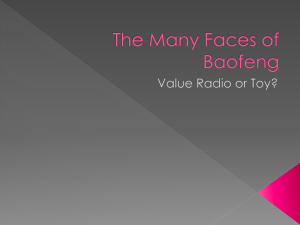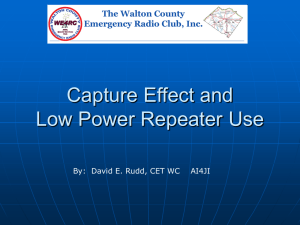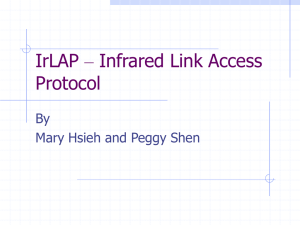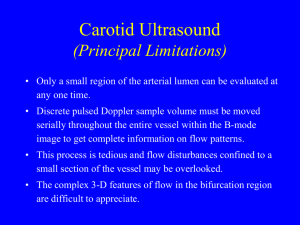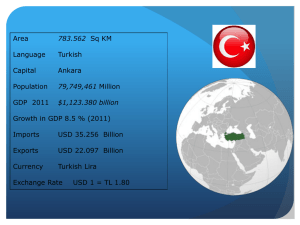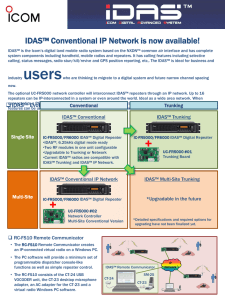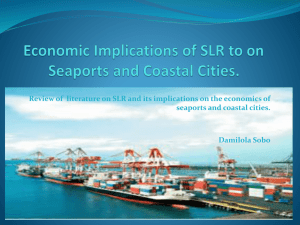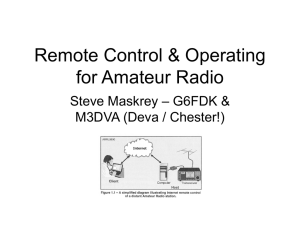Nova Scotia UHF Back Bone Linking System
advertisement
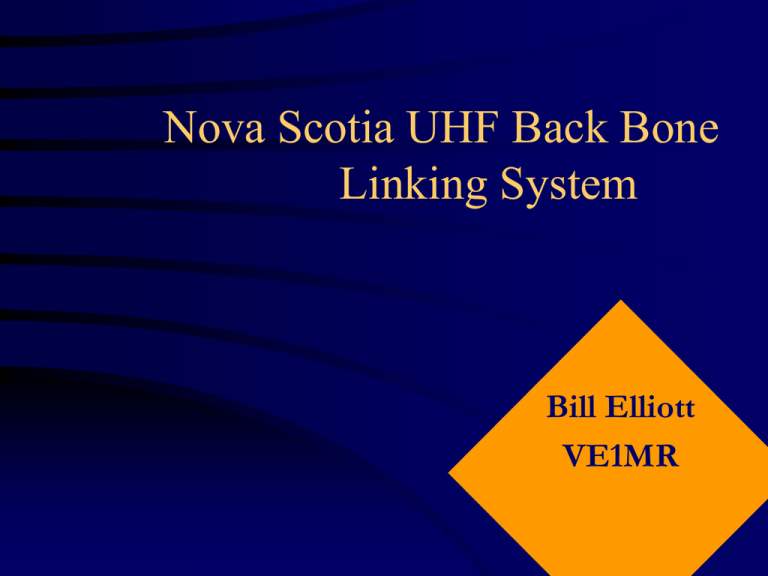
Nova Scotia UHF Back Bone Linking System Bill Elliott VE1MR Introduction We will introduce you to the UHF back bone system as currently implemented. 1) explanation of some terms. 2) overview of system. 3) detail 4) uses and limitations 5) linking etiquette We will also show how other means can be used to pass traffic into and out of other areas. Explanation of Some Terms Repeater A repeater is a Transmitter/Receiver on a particular VHF or UHF band that immediately transmits what it hears on the receiver. Repeaters generally have a tail - that is the transmitter stays on for a few seconds after the received signal ceases. There is usually a courtesy beep, identifiers and sometimes messages on repeaters. Explanation of Some Terms Link A link is generally a radio on a different frequency than the primary repeater. There are several types of links. Our system uses 3 different types. 1 - UHF HUB Repeaters 2 - UHF Half Duplex links 3 - UHF Full Duplex Links Explanation of Some Terms UHF HUB Repeater A HUB repeater is a true repeater in that it immediately transmits what it hears on the receiver. These repeaters normally do not have any tail - that is the transmit stops as soon as the received signal ceases. You will see later how these are used in the linking system. Explanation of Some Terms Half Duplex Half Duplex refers to a link radio that generally uses different transmit and receive frequencies but at any given time transmits or receives, not both at the same time. When a Half Duplex link radio is transmitting it cannot receive. When a Half Duplex radio is receiving it may go into transmit depending on the situation. You will see later how this may affect operation. Explanation of Some Terms Full Duplex Full Duplex refers to a link radio that uses different transmit and receive frequencies and can transmit and receive at the same time. When a Full Duplex link radio is transmitting it can receive without affecting what it is transmitting. When a Full Duplex radio is receiving it can also transmit without affecting what it is receiving. You will see later how this affects operation. Explanation of Some Terms Controller A controller generally refers to a piece of equipment to control a repeater or link or both. It takes care of things like tails, courtesy beeps IDs, messages, timers and other functions like connecting ports together. The programming of a controller can be quite simple or very complicated depending on functions required and auxiliary equipment added to it. Port A Port refers to a controller input/output for controlling a radio. Each port controls one radio for transmit and receive functions. In general the more ports a controller has the more it will cost. Explanation of Some Terms TIMERS • Link activity timer is generally 3 minutes. Most controllers are set to drop the transmitter after 3 minutes of continuous receive carrier - this applies to both repeaters and links. So if you think your monologue will be longer than 3 minutes take a short break to allow all timers to reset. • Link inactivity timer is generally 5 minutes. This will ensure the link will time out if there is no activity on the link for the set time. So if you drive out of the coverage area of a repeater you up linked, do not worry, the link will time out with no activity. • Often the inactivity timer on the repeater side will be set to a longer time typically 20 minutes. This allows listening to a net when no one is checking in from a particular repeater. Not all controllers allow this. Explanation of Some Terms Duplexer A Duplexer is a piece of equipment that allows one antenna to be used for both receive and transmit at the same time. It can be used on a Repeater or a Full Duplex Link. Hard Link A Hard link is one that is always up. This means that a Hard Link between 2 or more repeaters allows what is received on one repeater to be transmitted out all hard linked repeaters simultaneously. Hard links can use UHF HUB repeaters, Half Duplex links or Full Duplex links or any combination that will work. Explanation of Some Terms DTMF SIGNALLING DTMF is Dual Tone Multi Frequency, often called touch tone. For the linking system DTMF signalling uses a touch tone key pad normally mounted on the microphone or radio. Our linking system normally uses a 4 digit code according to a co-ordinated dialling plan. The various system controllers respond to their own code to link ports together, thus allowing control of receivers and transmitters. Why use different types of links 1 - Primarily due to equipment costs and availability of antennas on a particular tower. 2 - A HUB repeater can service many links to different sites with one antenna. The disadvantage is that links to a HUB repeater must be Half Duplex. 3 - Half Duplex links require less equipment and space. If a Half Duplex link does not go to a HUB repeater then it can be easily made into a Full Duplex link in the future with some modifications and the addition of a Duplexer. 4 - A Full Duplex link is the preferred method of linking as you will see later. QUESTIONS ON ANY THING SO FAR ?????? Overview We will take a quick look at the complete system more or less as it stands today. You will see the complexity of the backbone system but you actually do not need to understand all the paths involved but knowing some of the routes and the types of links involved will help you understand why certain things happen. I will then explain how some of the links work. OVERVIEW This map shows most of the repeaters in Nova Scotia Not all are linked OVERVIEW VE1BBC Red lines = Hard linked Yellow lines = UHF backbone system White lines = under construction OVERVIEW VE1BBC The white links under construction will be hard links OVERVIEW OVERVIEW OVERVIEW Now an overview of the types of link sites. 1) Full Duplex 2) Half Duplex 3) Half Duplex with HUB Repeater FULL DUPLEX TRUNK LINK SITE UHF BACKBONE VE1EFP East Kemptville VE1BO Port 2 Port 3 Port 1 Controller NRC VE1AAR DND HALF DUPLEX TRUNK LINK SITE UHF BACKBONE VE1SAB VE1MHR Cochrane Hill Jerusalem Hill Port 2 Port 3 Port 1 Controller VE1ESR Marionette HALF DUPLEX HUB LINK SITE UHF BACKBONE VE1CFR VY2UHF PEI PEI UHF HUB Repeater Controller Port 2 VE1SPR VE1HAR Port 1 Harmony Sugarloaf VE1BHS Aliant DETAIL I will now explain how some of the link sites work First we will look at VE1PSR link site. When the proper code is received it will connect port 1 to ports 2, 5 & 6 VHF repeater Main Link UHF repeater 6M repeater VE1HNS Link VE1MHR Link ECHO Link Port 1 Port 2 Port 3 Port 4 Port 5 Port 6 Port 7 VE1PSR Controller Note that and66 Notice thatport port1 2isisconnected connectedtotoports ports2,55and Notice the main link is Half Duplex Main Link Controller path VE1HNS Link While the VE1HNS link is Full Duplex A signal coming in on the main link will be retransmitted out to VE1HNS. If a signal comes in from VE1HNS will cause the main link radio to go into transmit and it will no longer receive. Half Duplex Main Link Full Duplex Controller path VE1HNS Link If you are listening on the main link you cannot reply until the main link stops transmitting. If you were to transmit on VE1HNS while the main link is receiving, you will cause the main link to transmit and cut off the incoming signal. Remember - a Full Duplex link can receive while transmitting. a Half Duplex link cannot receive and transmit at the same time. DETAIL Now we will look at some general link sites. VHF repeater VHF repeater Controller Controller Port 1 Port 1 Port 2 Port 3 Port 2 Port 3 Full Duplex link Full Duplex link Full Duplex link Full Duplex link This Bothrepresents sites have two full duplex link sites links in asosystem. traffic can flow in both directions at the same time Note that the link ports are connected This together is donebut for the technical repeaters reasons are not since most users connected use a to half theduplex links. radio. There are 2 main technical advantages. VHF repeater VHF repeater Controller Controller Port 1 Port 1 Port 2 Port 3 Port 2 Port 3 Full Duplex link Full Duplex link Full Duplex link Full Duplex link 2. 1. - the time onwith the alink is much - if turn therearound is a problem stuck less than or if Half Duplex links were used. transmitter open squelch then a signal can be sent back down the system to turn A quick example would be a set of links off the offending radio. using 5 link radios. InThe a half duplex system lossover of in receive Lets number say each of radio link radios haswith ainvolved turn from a link on the radio the radio should be transmit our first system to receive could of 5th 200 be up mstoand 25 or it takes more. receive in about 1000 ms. 100 ready ms to to bring the transmitter up to power Some will be full duplex some will be hub Then withduplex a received signal on theignore 5th radio In a repeaters full andsystem some will yoube can half duplex. the the first to radio should be around up in full transmit in receive transmit turn time and are This is why it is recommended that you key about only concerned with500 thems. time it takes the your microphone for about 2 seconds before transmitters to come up to power. Complete turn around is 1.5 seconds. speaking to allow all the radios to come up to With a signal on thepower. first receiver all 5 radios should be up to power in about 500 ms. The actual time lag is less than 2 seconds User 1 VHF repeater User 3 Controller Full Duplex Half link Duplex link HUB REPEATER Controller Full Duplex link VHF repeater User 2 User 1 VHF repeater User 3 Controller Full Duplex Half link Duplex link HUB REPEATER Controller Full Duplex link VHF repeater User 2 QUESTIONS ON ANY THING SO FAR ?????? SITE PHOTOS Many of you may not have ever seen a repeater site so here are some site photos. Springfield NSIMRS Tower Nuttby Aliant site VE1OBN Site VE1ESR Other means of passing traffic Some system repeaters have other types of links such as IRLP or Echolink IRLP is Internet Repeater Linking Project This uses the internet as the voice and signal carrier between repeaters. It is also accessed by DTMF signaling. Echolink is another type of internet linking and may use either radio or a computer - you are required to be a licensed Amateur Radio Operator to gain access via a computer. Both of these systems are world wide so as long as the internet is working at a site that has this type of linking, you can pass a message to any area of the province or world that also has this type of link. Other means of passing traffic Some other types of messaging can be used in many areas. There are VHF/UHF Packet systems existing in many parts of the province. We are in the process of rebuilding and refurbishing these networks. They fell out of general use but the emergency applications are being recognized and utilization by emergency agencies is increasing. Some of these systems exist in the Provincial grid sites. Packet is a slow form of the internet using radios and computers, most traffic is passed using 1200 baud with some at 9600 baud and a small portion at 19.2 K baud. There is error checking and some encryption and depending on how traffic is handled some messages cannot be read by others listening on the same frequency. Other means of passing traffic A newer type of messaging is coming into emergency communications use called Winlink or Packlink. These units are more expensive but can be used without special training. A Winlink station uses a standard e-mail program to send regular e-mail messages. When you send an e-mail the system will first try to use the internet, if unsuccessful or not available it will then try VHF or UHF packet at 1200 or 9600 baud, If that is not successful or unavailable it will then try to send the e-mail by HF packet at 300 baud if HF is available to it. The radio protocols used have very stringent error checking. Of course it is recommended that the e-mail message be relatively brief and not contain a huge attachment or large image. Having said that a lot of text can be sent and small file attachments or fairly small images can be sent. A less expensive alternative will soon be available - Winmore it does not have as robust error correction as Winlink. Other means of passing traffic Another means of passing a message is by HF radio. Many but not all emergency agencies have this capability. HF radio can send messages to isolated areas or out of an isolated area. Once a message is passed to an isolated area then local infrastructure can distribute the message to the proper authorities. If an area is isolated and can pass a message out of the area then normal communications can distribute it. Conclusion In a scenario where normal means of communication are disrupted, either overloaded or out of commission, the Amateur Radio community has the capability to communicate into and out of isolated areas by various means. The Maritime Voice ( MAVCOM ) link system is the easiest way for Amateur operators to pass message either as formal traffic handling or tactical message handling. The MAVCOM link system relies very heavily on our presence in the Nova Scotia Provincial radio sites. A similar system is supported by the provincial EMO in New Brunswick. PEI currently relies mostly on Aliant and municipal sites through MOU’s based on emergency communications. The Amateur Radio systems and capabilities cover the Maritime Provinces and beyond
